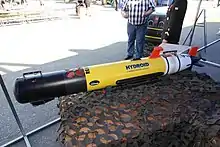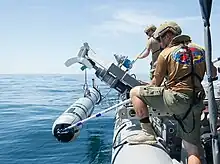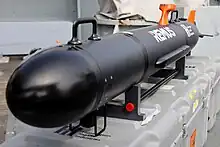REMUS (vehicle)
The REMUS (Remote Environmental Monitoring UnitS) series are autonomous underwater vehicles (AUVs) made by the Woods Hole Oceanographic Institution and designed by their Oceanographic Systems Lab (OSL). More recently REMUS vehicles have been manufactured by the spinoff company Hydroid Inc, which was a wholly owned subsidiary of Kongsberg Maritime.[1] Hydroid was acquired by Huntington Ingalls Industries (HHI) in March 2020.[2] The series are designed to be low cost, they have shared control software and electronic subsystems and can be operated from a laptop computer.[3] They are used by civilians for seafloor mapping, underwater surveying, and search and recovery as well as by several navies for mine countermeasures missions.

_with_an_autonomous_docking_station_from_Woods_Hole_Oceanographic_Institution_(WHOI)_is_lowered_into_the_water_pierside_during_the_Autonomous_Underwater_Ve.jpg.webp)
Models
There are a number of variants of the REMUS; all are torpedo-shaped vessels with reconfigurable sensors.
REMUS 6000
The largest model is the REMUS 6000 at 3.84 metres (12.6 ft) long and 71 centimetres (28 in) in diameter; it is named after its maximum diving depth of 6000m.[4] It can travel at speeds of up to 5 knots (9.3 km/h) and has an endurance of up to 22 hours.[4] It was developed through cooperation between the Naval Oceanographic Office, the Office of Naval Research, and the Woods Hole Oceanographic Institution (WHOI).[5]
In 2018 the Japan Agency for Marine-Earth Science and Technology (JAMSTEC) received an order of New Generation REMUS 6000 AUVs. The New Generation REMUS 6000 is based on the legacy REMUS 6000 platform with "a modular architecture that allows for the addition of multiple payloads including customer sensor packages, forward fins and additional battery sections.”[6] Hydroid also claims that the New Generation model has increased endurance.
REMUS 620
In November 2022, the development of the REMUS 620 was announced. It is an enhanced version of the REMUS 300, built to the same size as the REMUS 600. It has a battery endurance of up to 110 hours and a range of up to 275 nmi (509 km), depending on installed modules, and a sprint speed of 8 knots (15 km/h). With a synthetic-aperture sonar installed, battery life is reduced to 78 hours with a range of 200 nmi (370 km). Design missions include mine countermeasures, hydrographic surveys, intelligence collection, surveillance, cyber warfare and electronic warfare. It can also launch smaller UUVs or UAVs. It can be launched from submarines, surface ships, small manned or unmanned craft, and helicopters. It can be recovered underwater by submarines, and recovery back into torpedo tubes is being developed at Woods Hole.[7]
REMUS 600

The midsized REMUS 600 was previously known as the REMUS 12.75, so called due to its 12.75-inch (32.4 cm) diameter. It was renamed to the 600 to correspond to the maximum depth at which it can operate (600m).[8] It can travel at speeds of up to 5 knots (9.3 km/h) and has an endurance of up to 70 hours at its standard cruising speed of 3 knots (5.6 km/h).[8]
A US Navy derivative of this platform designated Mk 18 Mod 2 Kingfish was manufactured from 2012 to 2023.[9][10] The Mk 18 Mod 2 is equipped with side-scan sonar, a downward-looking video camera, ADCP, GPS, beam attenuation meter (BAM) to measure turbidity, and a conductivity temperature depth (CTD) sensor.[11][12]
A total of 175 REMUS 600s were delivered to customers in the United States, United Kingdom, Australia and Japan.[7]
REMUS 300
The small-sized REMUS 300 is a development of the REMUS 100, announced in April 2021. It has a length of 2.3 m (7 ft 7 in) and a diameter of 19 cm (7.5 in). The standard REMUS 300 weighs 56 kg (123 lb), but its modular design permits a 45.4 kg (100 lb) expeditionary configuration to a 67.6 kg (149 lb) long-endurance configuration. It can be configured with lithium-ion batteries for an endurance of up to 30 hours, with a maximum range of 165 km (89 nmi). It can dive to 305 m (1,001 ft) and has a speed of up to 5 knots (9.3 km/h).[13]
It is designed for mine countermeasures, search and recovery, rapid environmental assessment, hydrographic survey, anti-submarine warfare, and intelligence, surveillance and reconnaissance. It has civil applications in the fields of marine archaeology, renewables, and offshore oil and gas.[13]
In March 2022, the U.S. Navy selected the REMUS 300 as its next generation small UUV (SUUV).[14]
REMUS 100

The REMUS 100 takes its name from its max operating depth of 100 meters.[1] The US Navy operates a derivative of the REMUS 100, in addition to the standard REMUS 100, designated Mk 18 Mod 1 “Swordfish”.[15] It can travel at speeds of up to 5 knots (9.3 km/h) and has an endurance of up to 22 hours at its standard cruising speed of 3 knots (5.6 km/h).[15]
Operational history
REMUS units were used successfully in 2003 during Operation Iraqi Freedom to detect mines,[17] and in 2011 during the fourth search for the missing aircraft "black boxes" from the crashed Air France flight AF447,[18] which they successfully found.[19] Three REMUS 6000 units were used in the AF447 search.[20] In a video posted by Colombian president Juan Manuel Santos, a REMUS 6000 is seen being used by the Colombian Navy to examine the shipwreck, now patrimony, of galleon San José that sunk in 1708 off the coast of Cartagena de Indias.[21]
.jpg.webp)
In 2012, the mine detection-variant of the REMUS 600 was deployed by the US Navy to the 5th Fleet, operating primarily in the Persian Gulf.[22] REMUS vehicles in Navy service are generally deployed from 11-metre (36 ft) rigid hull inflatable boats, which can carry two vehicles,[11] although they have been deployed from littoral combat ship USS Freedom[23] and from an MH-60S Seahawk helicopter in exercises.[24] In 2018, a US Navy REMUS 600 named “Smokey” was captured by Houthi combat divers off the coast of Yemen; the Houthi forces published a video of the captured vehicle.[25]
The University of Hawaii at Manoa operates a REMUS 100 equipped to measure salinity, temperature, currents, bathymetry and water quality parameters. These measurements help support research conducted by the university's nearshore/offshore sensor network and water sampling programs.[26]
In 2017 a REMUS 6000 operated from the billionaire Paul Allen’s research vessel R/V Petrel helped discover the USS Indianapolis (CA-35) at 5,500m in the Philippine Sea.[27] In 2018 a REMUS 6000 operated from R/V Petrel discovered the wreck of the USS Lexington (CV-2) in the Western Pacific, the USS Lexington was sunk in 1942 during the Battle of the Coral Sea.[28]
In 2019 researchers at the University of Exeter used a Woods Hole Oceanographic Institution owned REMUS 100 based SharkCam off the coast of Coll and Tiree to study basking sharks.[29][30]
Operators

- United States Navy
- Woods Hole Oceanographic Institute
- Naval Oceanographic Office[31]
- University of Hawaii at Manoa[32]
- Japan Agency for Marine-Earth Science and Technology[38]
- Japan Maritime Self-Defense Force
- Remus 100 used as OZZ-1/3.[39]
- Remus 600 used as OZZ-2/4 at Awaji-class minesweeper[39][40]
- Ukrainian Navy Unmanned surface vehicles announced as military aid to be sent to Ukraine by the United Kingdom (from industry) in August 2022
See also
References
- "Marine Robots (AUVs) | Hydroid, Inc". www.hydroid.com. Archived from the original on 6 February 2016. Retrieved 12 June 2016.
- "HUNTINGTON INGALLS INDUSTRIES CLOSES THE ACQUISITION OF HYDROID INC". hii.com. 26 March 2020. Retrieved 28 April 2023.
- "REMUS". Woods Hole Oceanographic Institution. Retrieved 9 July 2012.
- "REMUS 6000". Woods Hole Oceanographic Institution. Retrieved 9 July 2012.
- "AUV System Spec Sheet". auvac.org. Autonomous Undersea Vehicle Application Center. Retrieved 8 January 2019.
- "Hydroid Receives Order for New Generation REMUS 6000 AUV from Japan Agency for Marine-Earth Science Technology (JAMSTEC)". prnewswire.com (Press release). prnewswire.com. Retrieved 8 January 2019.
- Burgess, Richard R. (7 November 2022). "HII Announces REMUS 620 Next-Generation, Submarine-Deployable Medium UUV". Seapower. Retrieved 22 July 2023.
{{cite magazine}}: Cite magazine requires|magazine=(help) - "REMUS in Photos". Woods Hole Oceanographic Institution. Retrieved 9 July 2012.
- "Mk 18 Mod 2 Kingfish configuration". AUVAC.com. AUVAC. Retrieved 6 July 2018.
- "HII completes production of Mk 18 Unmanned Underwater Vehicle Systems". Navy Recognition. 6 February 2023. Retrieved 22 July 2023.
- William W Sprigg (September 12, 2018). Enviromental [sic] Services for Unmanned Maritime Systems (Report). SPAWAR Contracts Directorate Office. N66001-18-T-2006. Retrieved September 18, 2018.
- "AUV System Spec Sheet - Mk 18 Mod 2 Kingfish configuration". AUVAC. Retrieved 22 July 2023.
- "REMUS 300 Unmanned Underwater Vehicle (UUV)". NavalTechnology. 21 March 2023. Retrieved 22 July 2023.
- Kumar, Nishant; Fabey, Michael (1 April 2022). "USN selects REMUS 300 UUV as next-generation SUUV programme of record". Janes. IHS. Retrieved 22 July 2023.
- "Swordfish Mk 18 Mod 1 configuration". auvac.com. auvac. Retrieved 6 July 2018.
- Leoni, Victoria (2018-04-11). "New undersea drones are smaller, cheaper and can be refueled deep under water". defensenews.com. Defense News. Retrieved 18 January 2019.
- Richard Scott (14 February 2008). "Clearing the way: UUVs evolve to meet front-line MCM requirements". IHS Jane's: Defense & Security Intelligence & Analysis. Retrieved 9 July 2012.
- Wil S. Hylton (4 May 2011). "What Happened to Air France Flight 447?". The New York Times.
The ship carried three Remus 6000 submarines, some of the most advanced underwater search vehicles on earth, which swept the seafloor in 20-hour runs.
- Cindy E. Rodriguez (4 April 2011). "Robots Find Many of the Missing Bodies Amid Wreckage of Air France Flight 447". abc.com. p. 1. Retrieved 9 July 2012.
- Jeff Wise (18 April 2011). "How Air France 447's Missing Wreckage Was Found—and Why It Took So Long". Popular Mechanics.
- "Hallazgo del Galeón San José – 5 de diciembre de 2015". Presidency of Colombia. Retrieved 6 December 2015.
- "MK18 Kingfish UUV Deployed to 5th Fleet" (Press release). Panama City, FL: Naval Surface Warfare Center Panama City Division Public Affairs. NNS. June 25, 2013. Retrieved 2018-09-18.
- DON Innovation (July 2017). "The Expeditionary MCM (ExMCM) Company: The Newest Capability in U.S. Navy Explosive Ordnance Disposal (EOD) Community" (Press release). Department of the Navy. Retrieved 2018-09-18.
- "US Navy deploys mine countermeasure UUV from helicopter". Naval Today. March 6, 2017. Retrieved 18 September 2018.
- Werner, Ben (2018-01-03). "VIDEO: Houthi Forces Capture U.S. Navy Unmanned Underwater Vehicle Off Yemen". news.usni.org. US Naval Institute. Retrieved 6 July 2018.
- "Remus AUV". soest.hawaii.edu. University of Hawaii Marine Operations. 2013-02-14. Retrieved 8 January 2019.
- "Wreckage From USS Indianapolis Located In Philippine Sea". paulallen.com. Paul Allen. Archived from the original on 20 August 2017. Retrieved 13 November 2018.
- Gallagher, Sean (6 March 2018). "World War II carrier "Lady Lex" found 2 miles under sea by Allen expedition". arstechnica.com. Ars Technika. Retrieved 13 November 2018.
- Howard, Michelle (6 August 2019). "SharkCam Reveals Secrets of UK Basking Sharks". www.marinetechnologynews.com. Marine Technology News. Retrieved 20 November 2019.
- "Robot cameras reveal secret lives of basking sharks". phys.org. Retrieved 20 November 2019.
- "Hydroid Delivers First High Resolution Interferometric Synthetic Aperture Sonar". kongsberg.com. kongsberg. Retrieved 6 July 2018.
- "Remus AUV". soest.hawaii.edu. University of Hawaii at Manoa. 2013-02-14. Retrieved 13 November 2018.
- "Royal Navy Demonstrates REMUS 600 UUV At 'Unmanned Warrior 16'". defenseworld.net. Defense World. October 15, 2016. Retrieved 6 July 2018.
- Pintarić, Vesna. "The Remus 100 Underwater Vehicles upgrading the Navy's countermine capabilities". hrvatski-vojnik.hr. hrvatski-vojnik. Retrieved 6 July 2018.
- "Hunt when you can". Kongsberg.com. Kongsberg. Retrieved 6 July 2018.
- "RNLN Integrates SeeByte's Neptune into its AUVs". marinetechnologynews.com. Marine Technology News. 2018-09-28. Retrieved 13 November 2018.
- "New REMUS 100 for the Royal Canadian Navy". lookoutnewspaper.com. Lookout Newspaper. 2018-10-18. Retrieved 13 November 2018.
- "Hydroid Bags AUV Order from Japan". marinetechnologynews.com. Marine Technology News. 2018-11-19. Retrieved 23 December 2018.
- Koji Inoue (2022-03-23). "海自UUV その現況と将来展望". 世界の艦船. 海人社.
- "掃海艦あわじ". Retrieved 2023-03-05.
- "Irish navy training with Remus 100 AUV". Irish naval service facebook page. Retrieved 13 October 2019.
- "NZ Defence Force: Searching for the missing". NZDF YouTube video. 2021-06-02. Retrieved 2021-06-03.